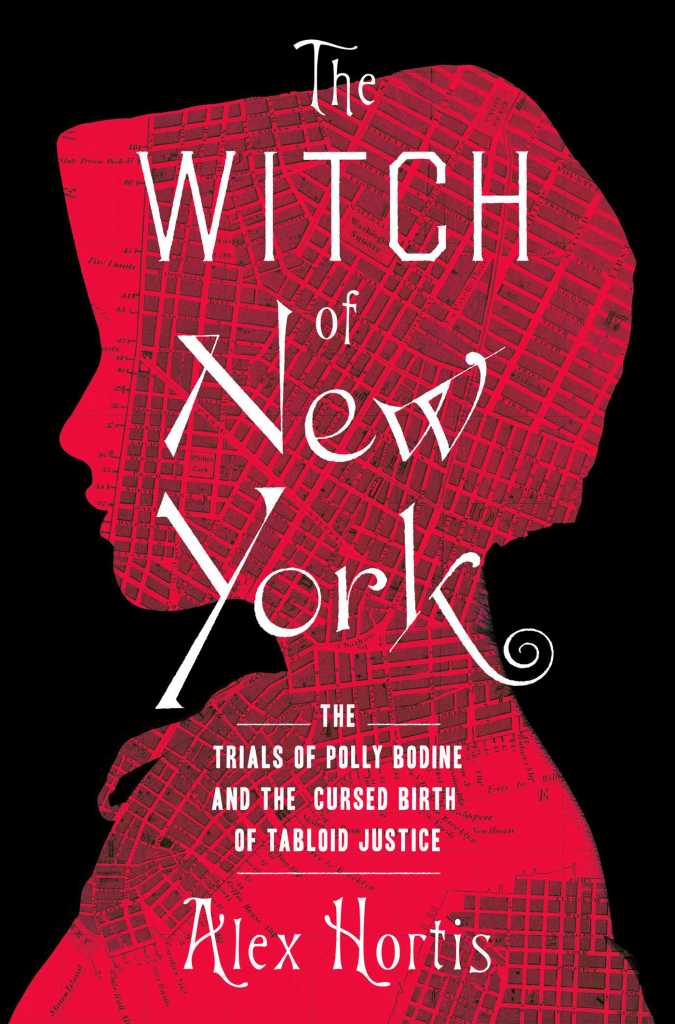
The Witch of New York: The Trials of Polly Bodine and the Cursed Birth of Tabloid Justice
- Author: Alex Hortis
- Genre: True Crime
- Publication Date: March 4, 2024
- Publisher: Spotify Audiobooks
Thank you to NetGalley and Spotify Audiobooks for providing me with a copy of this audiobook in exchange for an honest review.

Before the sensational cases of Amanda Knox and Casey Anthony—before even Lizzie Borden—there was Polly Bodine, the first American woman put on trial for capital murder in our nation’s debut media circus.
On Christmas night, December 25, 1843, in a serene village on Staten Island, shocked neighbors discovered the burnt remains of twenty-four-year-old mother Emeline Houseman and her infant daughter, Ann Eliza. In a perverse nativity, someone bludgeoned to death a mother and child in their home—and then covered up the crime with hellfire.
When an ambitious district attorney charges Polly Bodine (Emelin’s sister-in-law) with a double homicide, the new “penny press” explodes. Polly is a perfect media villain: she’s a separated wife who drinks gin, commits adultery, and has had multiple abortions. Between June 1844 and April 1846, the nation was enthralled by her three trials—in Staten Island, Manhattan, and Newburgh—for the “Christmas murders.”
After Polly’s legal dream team entered the fray, the press and the public debated not only her guilt, but her character and fate as a fallen woman in society. Public opinion split into different camps over her case. Edgar Allen Poe and Walt Whitman covered her case as young newsmen. P. T. Barnum made a circus out of it. James Fenimore Cooper’s last novel was inspired by her trials.
The Witch of New York is the first narrative history about the dueling trial lawyers, ruthless newsmen, and shameless hucksters who turned the Polly Bodine case into America’s formative tabloid trial. An origin story of how America became addicted to sensationalized reporting of criminal trials, The Witch of New York vividly reconstructs an epic mystery from Old New York—and uses the Bodine case to challenge our system of tabloid justice of today.

The title is what caught my attention, and the fact that I’ve never even heard about Polly Bodine or this case, which made major headlines at the time. We’re all very familiar with the way that cases are tried in the media before a court decision is ever rendered, and the way that people are trial are put through the wringer in the media. But our society is also more than familiar with the right that an accused person has to a fair and unbiased trial. It was this case that highlighted that need and made this a landmark case.
I was approved for the audiobook of this, and the narrator did a fantastic job with this book. Erin Bennett presents all of the information in a clear voice that makes it all feel easy to stay focused on.
This is a really well-researched book. There’s so much information being presented in the story, and it couldn’t have been easy to wade through all of the conflicting reports—the scathing news stories, the court records, the character attacks, and the aggravating nature of following a case from the 1840s, and seeing how misogyny and prejudice played a role in her character assassination.
While there isn’t any witchcraft that actually occurs in the story, society hasn’t changed very much in the nearly 200 years since these events occurred. Women who don’t fit into the expectations of society, whatever the changing norms are, get labeled as witches, as something outside the norm, as women with loose morals, bad character, and more. The newspapers of the time, with headlines written by famous names like Edgar Allan Poe and Walt Whitman, printed images accompanying the stories that depicted her as a hook-nosed witch. And since this was the first time that a court case was accompanied by media involvement, there was no established protocol to prevent the jury from making a decision about Polly Bodine in advance of hearing any evidence at all, thereby preventing her from receiving a fair and unbiased trial.
There are so many facts presented. Readers are given the relatively scanty evidence collected by the police, as well as the court documents of prosecution and defense sides. However, we learn so much about how crime scene processing has evolved over the years between then and now. There were so many ways in which the investigation fell short of collecting potentially important evidence, but at the same time, there was no way to analyze the evidence that would be vital to an investigation today—microscopic evidence, bloodstains, burn patterns, and the bones themselves.
Ultimately, this wound up being a bit more of a slow paced read than I was expecting, and it wound up being a bit repetitive in a lot of parts. I found it incredibly frustrating to hear about how poorly Polly was treated simply for being a woman who was involved with a man she was not married to, for becoming pregnant out of wedlock, or for behaving in a way that society deems outside of expected roles. But at the same time, I liked how there was at least one person in Polly’s corner, fighting for her to get a fair trial. This is the kind of book that is going to stay with me because Polly deserves to have a more fair picture of her painted for history to remember her by than the one in the media of her day, but I struggled to really connect with the story.
Disclaimer: This post contains affiliate links, and I may earn a small commission at no cost to you if you purchase through my links.
Categories: Book Review

2 replies »